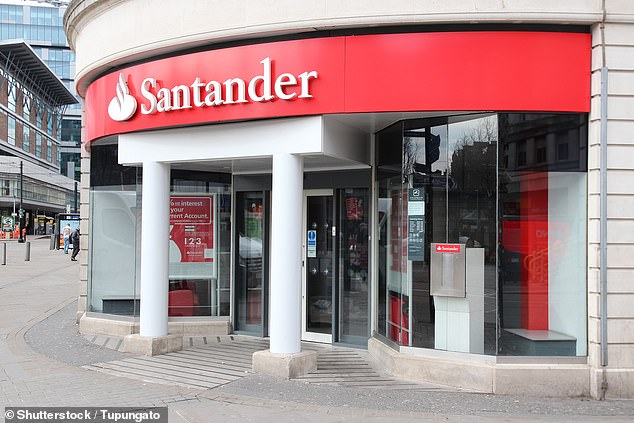We got a shock last week when Santander announced a massive 20 per cent cut to one of its highest savings rates.
The bank, which has more than 14 million customers, said it was acting proactively as it expects the Bank of England’s base rate to fall in the coming months.
A few days after the announcement of the shock reduction, it increased its mortgage rates. Hopefully others won’t follow suit and cut their savings rates, especially since the base rate has yet to fall from its current level of 5.25 percent.
I fear that all the positive progress made last year by the powerful Treasury committee, when it put pressure on the big banks to start rewarding savers with slightly higher interest rates, will be very quickly destroyed.
This morning, the same committee will again question the bosses of Barclays, Lloyds, NatWest and Santander to find out whether they provide a fair deal to their customers.

Sleight of hand: Santander, which has more than 14 million customers, said it was acting proactively by cutting one of its highest savings rates by 20%.
But don’t expect much improvement over these standard, easy-access accounts. The banks have changed them slightly since they first checked, but they still only pay 1.2 percent.
Santander’s surprise interest rate cut last week should be a clear reminder that we need to keep a close eye on the rate we earn on our savings.
Many of us don’t, as a recent Shawbrook study shows. Looking through the recently published report and accounts of the major banks for last year, one becomes alarmingly aware of the importance of this issue.
Lloyds, NatWest, Santander, Barclays and HSBC made billions of extra pounds off our complacent tendencies last year. Bankers made record profits, much of which they withheld from savers.
They are increasing their net interest margins – the difference between the amount they pay savers and what they charge borrowers – and have given their savers on their easy-access standard accounts as few benefits as possible.
The Bank of England’s monetary policy committee meets tomorrow to vote on its key rate.
Economists told me they expect interest rates to stay at 5.25 percent and that cuts will come later.
The base rate is expected to gradually fall to 4.2 percent by the end of the year.
But that didn’t stop Santander from prematurely removing its Easy Access Saver Limited Edition 3.
This is a massive reduction from 5.2 percent to 4.2 percent compared to mid-May. The bank launched the account in September 2023 in a “snatch and run” ruse.
Trusted figures specialists told me the bank took in billions of pounds while the account was on sale for just eight days, putting it at the top of the best buy charts.
The bank says the recent reduction is due to current market conditions.
Santander’s move contrasts sharply with the slowness with which big banks reacted when the policy rate began to rise just over three years ago. It took them four months to pass on part of this increase to savers.
Big banks have increased their offerings on fixed-rate bonds – but are still far behind newer banks, where a host pays more than 5 percent for a year.
Barclays is the best of a bad bunch with 4.65 per cent, while Santander pays just 4.1 per cent and Halifax 4.15 per cent.
They also offer better overall rates on some of their variable rate accounts.
But they usually only pay them for a year. For example, the overall rate for Santander Easy Access Saver Limited Edition 3 drops to just 1.2% after 12 months when your money is transferred from the account to its Everyday Saver.
Halifax Bonus Saver pays 4.1 percent, but only for one year, and to those who make three or fewer withdrawals during that time.
After 12 months, you end up in its Instant Saver with a lousy rate of between 1.45 percent and 1.8 percent.
These “go-to” rates look particularly pathetic compared to competitors that pay more than 5 percent, with the highest rate being Charter Savings Bank’s 5.08 percent.
The average rate, according to data analyst Moneyfacts, is 3.18 percent.
The easily accessible cash Isa rates from the big banks are just as bad. One of the worst is Barclays’ 1.16 per cent.
The Santander Isa Saver at 1.2 percent and Lloyds Bank at 1.4 percent are also terrible when you can earn over 5 percent with other providers such as Chip (5.1 percent), Zopa ( 5.08 percent), Charter Savings Bank (5.03 percent), and Harpenden Building Society and Kent Reliance, both at 5.01 percent. The average rate is 3.32 percent.
Sy.morris@dailymail.co.uk
Some links in this article may be affiliate links. If you click on it, we may earn a small commission. This helps us fund This Is Money and keep it free. We do not write articles to promote products. We do not allow any commercial relationships to affect our editorial independence.

